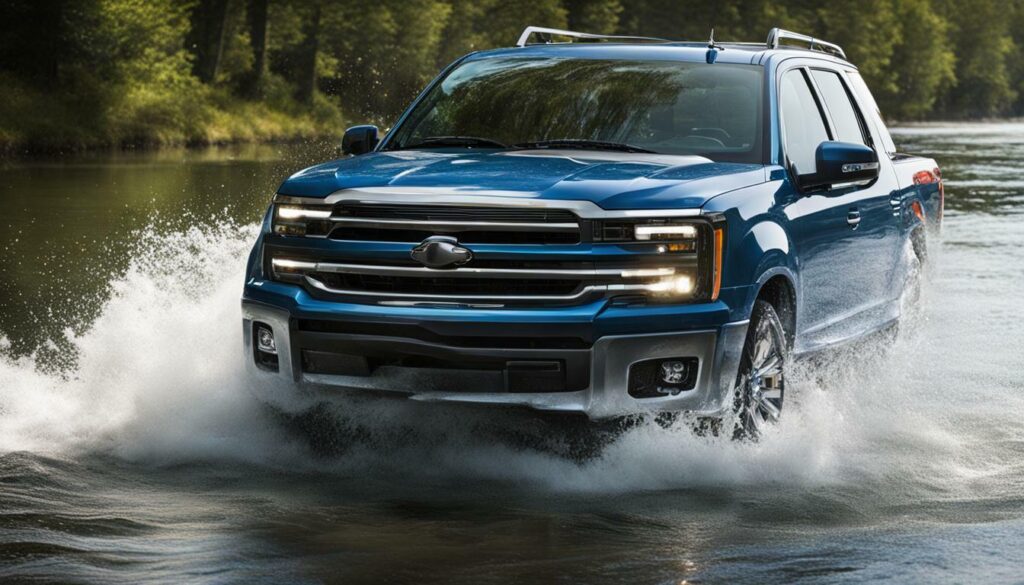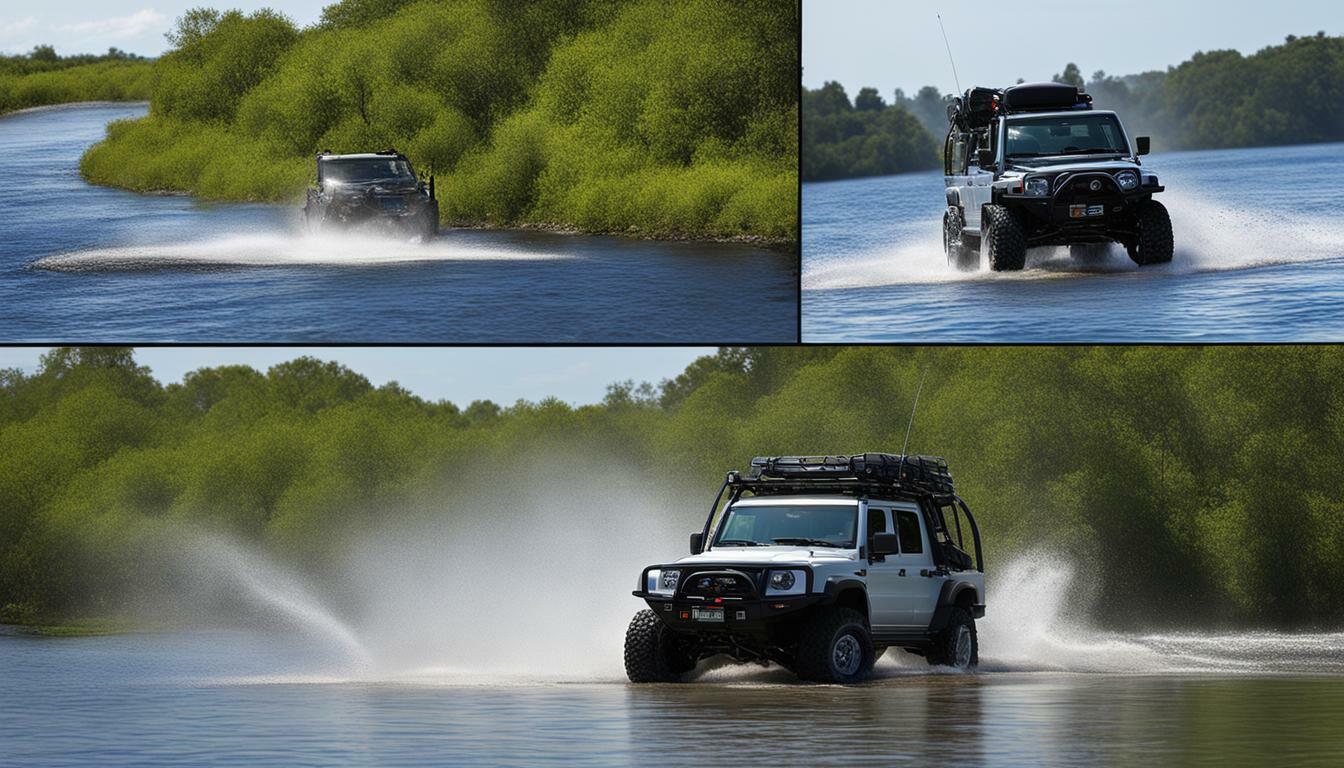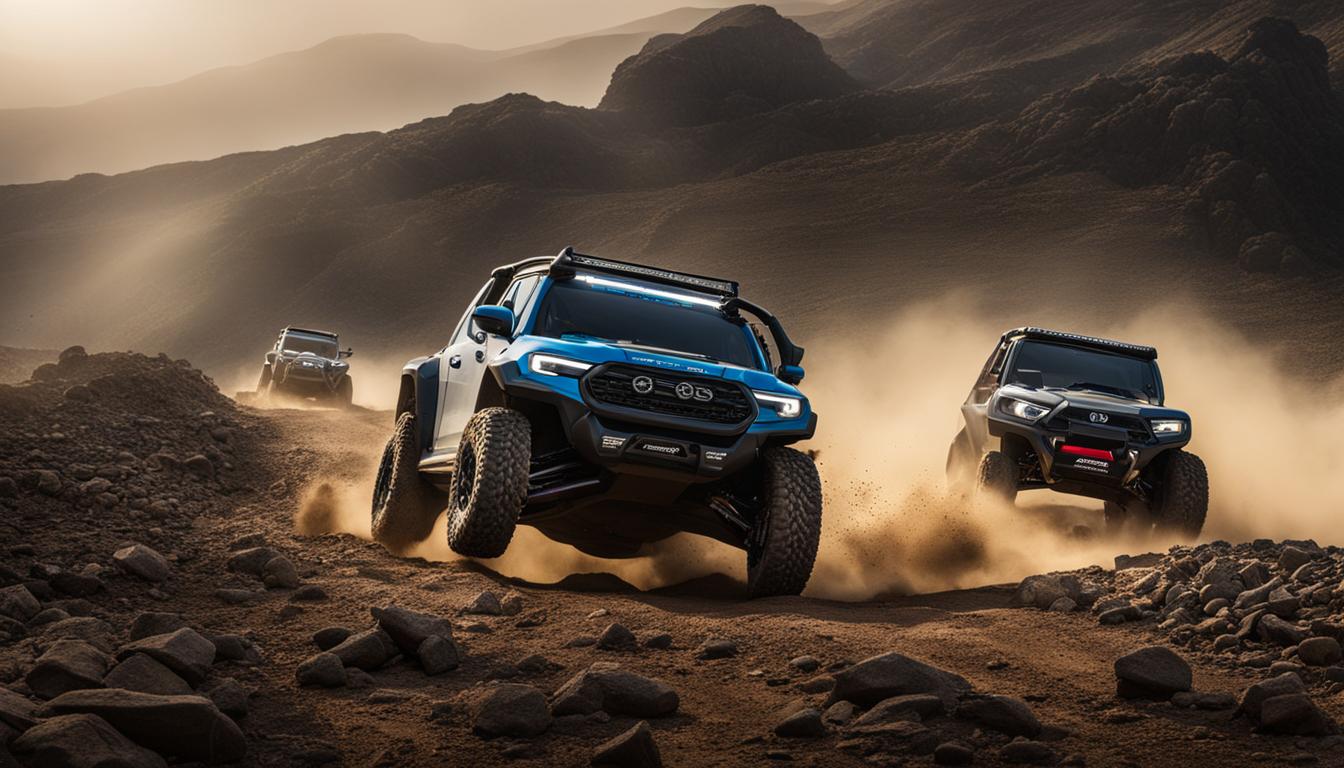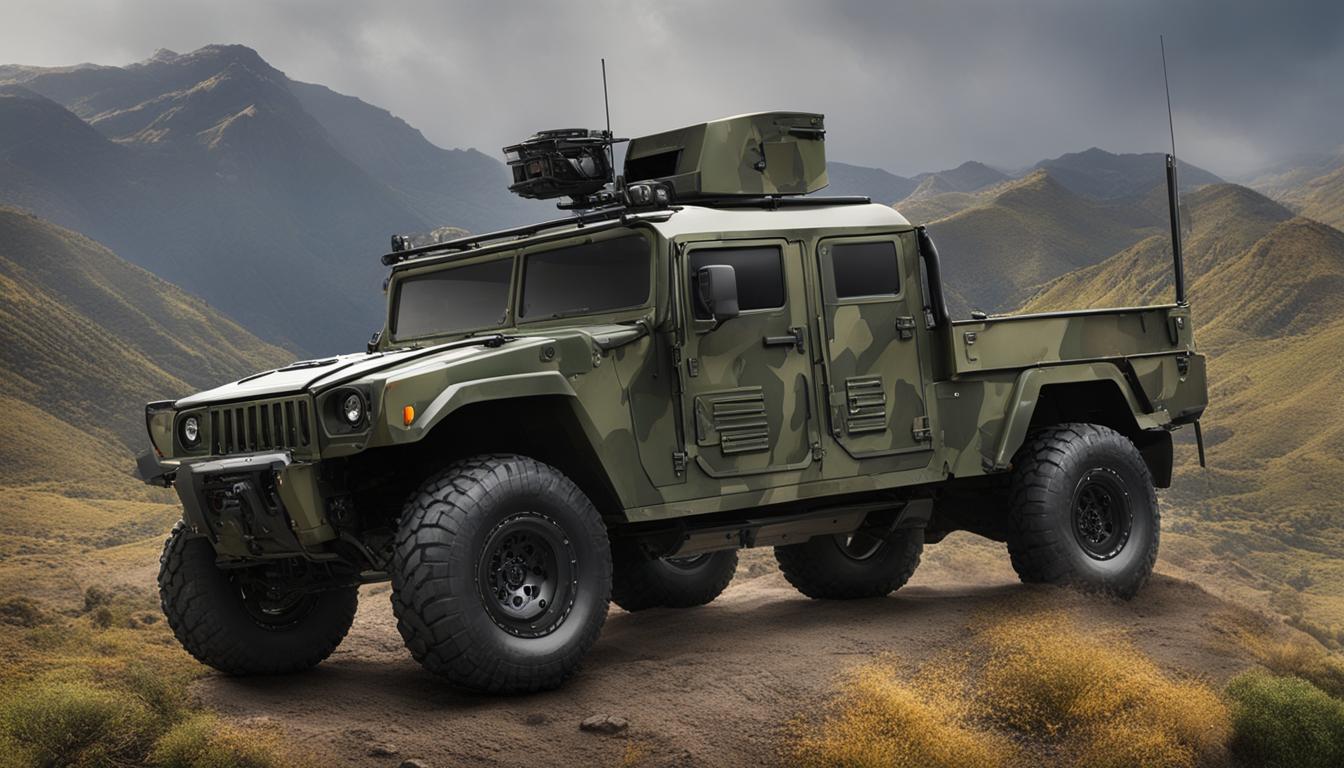When it comes to water crossing and off-road adventures, having the right equipment is crucial. One of the key decisions to make is whether to opt for a snorkel or a raised air intake. These accessories, also known as 4×4 snorkels, play a vital role in protecting the engine from dust, debris, and water during off-road driving and water crossings.
A snorkel lifts the air intake above the road surface, where the majority of dust concentration occurs, ensuring cleaner air for improved engine performance. It also provides a higher air inlet for water crossings, reducing the risk of water entering the engine and causing damage. On the other hand, raised air intakes offer similar benefits by safeguarding the engine from contaminants, allowing for a smoother and more enjoyable off-road experience.
Proper installation and sealing of the snorkel are essential for its effectiveness. Additionally, waterproofing the ignition system and raising the differential and gearbox breathers are recommended precautions to ensure optimal performance during water crossings.
Snorkels are available from various brands, and one popular choice is the ARB Safari Snorkel. Installing a snorkel involves removing fender flares and liner, affixing a template, drilling holes, mounting studs and brackets, sealing the intake system, and attaching the snorkel head. It is important to position the ram air intake head correctly for different weather conditions.
For added protection, snorkel pre-cleaners like cyclonic filters can be used to minimize the risk of dust and debris entering the air intake. These accessories serve as important modifications to enhance the longevity and performance of the engine during off-road adventures.
Key Takeaways:
- Snorkels and raised air intakes are essential off-road vehicle accessories for water crossings and off-road driving.
- Snorkels provide cleaner and cooler air for improved engine performance, while raised air intakes safeguard the engine from dust, debris, and water.
- Proper installation, sealing, and precautions like waterproofing the ignition system and raising breathers are necessary for effective use of snorkels.
- Snorkels can be purchased from various brands, with the ARB Safari Snorkel being a popular choice.
- Cyclonic filters can be used as pre-cleaners to offer additional protection for the air intake.
Benefits of Snorkels
Snorkels offer a range of benefits that make them an essential piece of water fording equipment and a popular choice for off-road vehicle modifications. One of the primary advantages of using a snorkel is the provision of cleaner air to the engine. By raising the air intake location, a snorkel helps to prevent dust and debris from entering the engine, reducing the risk of engine damage and improving overall performance.
Furthermore, snorkels provide cooler air for the engine, which can have a significant impact on its performance during off-road adventures. The higher air inlet provided by a snorkel ensures that the engine draws in cooler air from above the road surface, where the temperature is usually lower. Cooler air helps to maintain optimal engine temperature and can result in better fuel combustion and increased power output.
Another crucial benefit of using a snorkel is its role in ensuring safer water crossings. When crossing rivers or other bodies of water, a properly installed snorkel prevents water from entering the air intake system, which can lead to hydro-locking and severe engine damage. By raising the air intake above the water level, a snorkel allows the vehicle to ford through water without the risk of stalling or damaging the engine.

Enhancing Off-Road Experience
In addition to these functional benefits, snorkels also enhance the overall off-road driving experience. They give off-road enthusiasts the confidence to navigate dusty trails and tackle water crossings, knowing that their engine is protected and performing optimally. Snorkels are available from various brands, but the ARB Safari Snorkel is a popular choice among off-road enthusiasts due to its durability and reliable performance.
Installing a snorkel involves a few essential steps: removing fender flares and liner, affixing a template, drilling holes, mounting studs and brackets, sealing the intake system, and attaching the snorkel head. Proper positioning of the ram air intake head is crucial for different weather conditions, ensuring maximum airflow and protection.
Snorkels serve as an important modification for ensuring clean air intake and protecting the engine during off-road adventures.
When using a snorkel, it is recommended to consider additional precautions such as installing snorkel pre-cleaners, like cyclonic filters. These pre-cleaners provide an extra layer of protection by removing larger particles and debris from the air before it enters the engine. By extending the life of the air filter, pre-cleaners help to maintain optimal engine performance and reduce maintenance costs.
Overall, snorkels are an invaluable addition to any off-road vehicle, offering cleaner air, cooler air for improved engine performance, and enhanced safety during water crossings. Whether you’re a seasoned off-road enthusiast or a casual adventurer, investing in a snorkel will undoubtedly elevate your off-road experience and protect your engine from the hazards of dust, debris, and water.
Benefits of Raised Air Intakes
Just like snorkels, raised air intakes are a valuable addition to your off-road vehicle, providing a range of benefits when it comes to water crossings and off-road driving. These modifications elevate the air intake location, ensuring that your engine stays protected from dust, debris, and water, ultimately enhancing its performance and longevity.
One of the main advantages of raised air intakes is their ability to shield the engine from dust and debris that can be present during off-road adventures. As 4×4 vehicles navigate through rough terrains, the wheels kick up dirt, rocks, and other particles that can infiltrate the engine compartment. By raising the air intake, raised air intakes effectively minimize the risk of these contaminants entering the engine, reducing the chances of clogs, damage, and decreased performance.
Furthermore, raised air intakes play a crucial role in water crossings. When crossing rivers, streams, or flooded areas, having a higher air inlet is essential to prevent water from entering the engine. By elevating the air intake, raised air intakes provide an added layer of protection, keeping the engine safe and dry, and ensuring that your off-road adventure continues smoothly.
Installation of raised air intakes may vary depending on the vehicle make and model, but it typically involves removing the factory airbox and air intake system, and replacing them with the raised air intake system. It is important to follow the manufacturer’s instructions carefully to ensure a proper and secure installation, enabling maximum effectiveness.
In summary, raised air intakes offer significant benefits for off-road enthusiasts. They provide added protection to your engine by keeping dust, debris, and water at bay, resulting in improved performance and durability. If you enjoy off-road driving and water crossings, consider investing in a raised air intake to enhance your vehicle’s capabilities and maximize your off-road experience.
| Benefits of Raised Air Intakes |
|---|
| Protection from dust and debris during off-road adventures |
| Prevention of water entering the engine during water crossings |
| Improved engine performance and longevity |
Installation and Precautions for Snorkels
Installing a snorkel properly is crucial for its optimal performance during water crossings and off-road expeditions. Here are the steps to follow for a successful snorkel installation:
- Begin by removing the fender flares and liner to access the mounting location for the snorkel.
- Next, affix the template provided with the snorkel kit onto the designated area of the vehicle’s bodywork. This template will guide you in drilling the necessary holes for mounting.
- With the template in place, carefully drill the holes as indicated. Take caution to avoid damaging any internal components or wiring.
- Once the holes are drilled, insert the mounting studs and brackets provided in the kit into the corresponding holes. Make sure they are securely fastened.
- Seal the intake system of the snorkel using silicone or a similar weather-resistant sealant. This step is crucial for preventing any water leakage into the engine.
- Finally, attach the snorkel head at the top of the mounting studs and secure it tightly. Ensure the positioning of the ram air intake head is suitable for different weather conditions.
Proper positioning of the snorkel head is essential to prevent water ingress and maintain a steady flow of clean air to the engine. It is recommended to consult the manufacturer’s guidelines for the optimal position based on your vehicle model.

Additional Precautions:
- Waterproof the ignition system to safeguard it against moisture and water splashes.
- Raise the differential and gearbox breathers to prevent water from entering these components during deep water crossings.
- Regularly inspect and clean the snorkel inlet and air filter to ensure proper airflow and prevent any blockages.
By following these installation steps and taking the necessary precautions, you can ensure that your snorkel functions effectively, providing clean air intake and protecting your engine during off-road adventures.
| Installation Steps: | Precautions: |
|---|---|
| 1. Remove fender flares and liner | – Waterproof ignition system |
| 2. Affix template and drill holes | – Raise differential and gearbox breathers |
| 3. Insert mounting studs and brackets | – Regularly inspect and clean snorkel inlet and air filter |
| 4. Seal intake system with silicone | |
| 5. Attach snorkel head securely |
Additional Considerations for Snorkels
While the installation of a snorkel is essential, there are additional considerations that can further enhance its performance and longevity. One such consideration is the use of snorkel pre-cleaners, specifically cyclonic filters, which provide extra protection for the air intake system. These pre-cleaners are designed to remove larger particles, such as dust and debris, before they reach the main air filter, prolonging its lifespan and ensuring cleaner air intake.
Another important factor to consider is the positioning of the ram air intake head. This component directs the air into the snorkel and ultimately into the engine. Depending on the weather conditions you may encounter during your off-road adventures, you can adjust the position of the ram head to optimize performance. For example, in dusty environments, positioning the head facing backward can help reduce the amount of dust entering the snorkel.
When it comes to purchasing a snorkel, there are various brands available in the market. One popular choice among off-road enthusiasts is the ARB Safari Snorkel. It is well-known for its durability, quality, and compatibility with a wide range of off-road vehicles. Whether you choose the ARB Safari Snorkel or another brand, make sure to select one that is specifically designed for your vehicle model to ensure proper fitment and functionality.
| Considerations for Snorkels | Benefits |
|---|---|
| Snorkel Pre-Cleaners | Provide extra protection for air intake system |
| Positioning of Ram Air Intake Head | Optimize performance based on weather conditions |
| Choosing the Right Brand | Durable, quality construction for long-lasting use |
While the installation of a snorkel is crucial for off-road enthusiasts, taking these additional considerations into account can significantly enhance the performance and longevity of your snorkel. From using pre-cleaners to optimize the position of the ram head, each factor contributes to a cleaner air intake system and better engine protection during your off-road adventures.

In conclusion, snorkels are valuable off-road vehicle accessories that protect the engine from dust, debris, and water during water crossings and off-road driving. By considering additional factors such as snorkel pre-cleaners, proper positioning of the ram air intake head, and choosing the right brand, you can maximize the benefits and functionality of your snorkel. Implementing these additional considerations will ensure a cleaner air intake, enhance engine performance, and prolong the lifespan of your off-road vehicle.
Conclusion
Making the right choice between snorkels and raised air intakes is crucial for enhancing your off-road experience and ensuring a safe and successful water crossing. These off-road vehicle accessories play a vital role in protecting the engine from dust, debris, and water during rugged adventures. Snorkels and raised air intakes, also known as 4×4 snorkels, elevate the air intake location to provide cleaner and cooler air for improved engine performance.
A snorkel lifts the air intake above the road surface, where the majority of dust concentration occurs, effectively reducing the risk of engine damage caused by these particles. Additionally, it offers a higher air inlet for water crossings, allowing you to tackle river crossings and deep puddles with confidence. By providing a reliable source of clean air, snorkels ensure optimal engine performance even in challenging off-road conditions.
When considering a snorkel installation, it is essential to follow the proper procedures for positioning and sealing. This includes waterproofing the ignition system and raising the differential and gearbox breathers to prevent water from entering critical components. Various brands offer snorkels, with the ARB Safari Snorkel being a popular choice due to its quality and reliability.
For additional protection, snorkel pre-cleaners, such as cyclonic filters, can be installed to provide an extra layer of defense against contaminants. These filters help to remove larger particles from the air before it enters the engine, further safeguarding its performance and longevity. Whether you choose a snorkel or a raised air intake, these accessories serve as important modifications, ensuring clean air intake and protecting the engine during your off-road adventures.
FAQ
What is the difference between snorkels and raised air intakes?
Snorkels and raised air intakes, also known as 4×4 snorkels, serve the same purpose of elevating the air intake location in a vehicle for off-road driving and water crossings. The main difference is that snorkels are designed specifically for water crossings, providing a higher air inlet, while raised air intakes protect the engine from dust and debris.
What are the benefits of using snorkels?
Snorkels offer several advantages for off-road driving and water crossings. They provide cleaner air by lifting the intake above the road surface where dust concentration is high. Snorkels also allow cooler air intake, improving engine performance, and ensure safer water crossings with the elevated air inlet.
What are the benefits of raised air intakes?
Raised air intakes offer protection for the engine from dust, debris, and water during off-road driving. They enhance engine performance and longevity by preventing clogging and damage to the air intake system. Raised air intakes are essential for maintaining the engine’s efficiency in challenging off-road conditions.
How do I install and take precautions with snorkels?
Proper installation and precautions are crucial for the effectiveness of snorkels. The installation process involves removing fender flares and liners, affixing a template, drilling holes, mounting studs and brackets, sealing the intake system, and attaching the snorkel head. Additionally, it is important to waterproof the ignition system and raise differential and gearbox breathers for complete protection.
Are there any additional considerations for snorkels?
Yes, there are additional considerations for snorkel usage. Pre-cleaners, such as cyclonic filters, can provide added protection for the air intake, ensuring cleaner air intake. Various brands offer snorkels, with the ARB Safari Snorkel being a popular choice. Proper positioning of the ram air intake head is crucial for different weather conditions.



